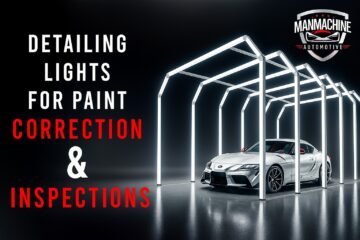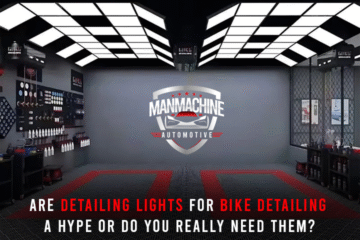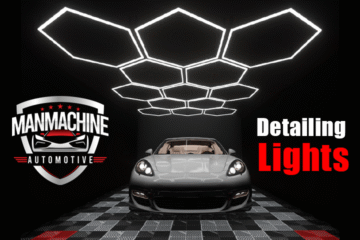In the sector of professional car detailing, every detail matters. From paint correction to cleaning interiors, not only effective finish matter, but also the right system and tools matter. One such tool is lighting, in particular the color temperature in detailing lights. Although it is able to appear to be a technical color, the appropriate colour temperature can distinguish between a feature and absolutely performed work.
In this blog, we need to recognise the color temperature in detailing lights and how it influences the work. The proper light layout is essential for the detailers and the automobile enthusiasts.
Understand the Color Temperature in Detailing Lights
The colouration temperature refers to the appearance of mild light coming out through the bulb, measured in Kelvin (K). It varies from warmth (yellow/red tones) to cold (blue/white tones).
Here’s a brief breakdown:
- Warm White (2000k-3500k): Yellowish, light reminiscent of morning sun light.
- Neutral white (3500K-4500K): Balanced white light with the least yellow or blue tint.
- Cool White (4500K-6000K): Crisp, natural white light.
- Daylight (6000K-7000K): Blue, severe, tinted light that mimics the daylight.
When it comes to the detailing work, the range from 4500K and 6500K, wherein magic occurs.
Why is the Color Temperature So Crucial in Photos?
You can be amazed why the color of a light matters so much, after all of the glow isn’t always sufficient? Not sufficient. Here is the reason why the color temperature in detailing lights matters:
1. Color Temperature in Detailing Lights
Correct colour rendering is required when improving paint or touch-up. The shade of the incorrect colour (very warm or very cold) can distort the light. 2700k light can throw a yellow color, while 7000k light can be blue.
2. Highlighting the swirl, scratches, and imperfections
Deficiencies such as swirl marks, scratches, holograms, water spots, or hazing can be very subtle. Detailing lights in the correct color temperature in detailing lights scale, especially around 5000K -6000K, provides the contrast and clarity that is been required to pop these errors.
This is especially important when improving multi-stage paint correction, where detailers have to make assessments must be made to ensure their progress and accurately limit their techniques.
3. Constant results in different light environments
Imagine completing a detailed job in your studio with warm lights, just look at the car under the sun, and feel it’s not so good. This deviation occurs when the light in your studio does not mimic natural daylight. The daylight balanced lighting (~ 5500K-6500K) ensures what you see in your store and what the customer is looking at on the road is the same.
4. Reduce eye fatigue for the detailers
Detailers are careful work who often take hours. Working under incorrect color temperature in detailing lights can cause eye stress and fatigue. Proper light is neutral white to daylight spectrum, not only improving visibility but also lessening the stress on the eyes, so professionals can work longer without discomfort.
5. Enhanced visual contrast for internal detailing
When cleaning the interior of the vehicle, especially around dark-colored upholstery, a color temperature in detailing lights around Trim then 5000K provides excellent contrast without oversaturation. This helps detect stains, debris, and residue more efficiently than a warm or excessive blue-colored light.
Incorrect Color Temperature Can Cost You
Let’s consider a landscape where a detail uses 3000K halogen floodlights in a garage. Under these warm conditions, the spread of scratches and holograms can be almost invisible due to soft lighting. After completing a composite and Polish job, the vehicle looks flawless in the studio. However, when the customer inspects the car under sunlight or LED lights for auto detailing (~ 6000K), the errors suddenly appear, causing dissatisfaction and potentially damaging your reputation.
If the detailer had used the best lighting for car detailing close to 5500K -6000K, these errors would have been more visible during improvement, and they would have been possible to solve before delivery.
Best Color Temperatures for Different Detailing Tasks
Here is the table of top color temperature in detailing lights and various detailing work as follows:
| Task | Recommended Color Temperature | Why It Matters |
| Paint Correction | 5000K–6000K | Reveals swirls, scratches, and holograms clearly. |
| Interior Detailing | 4500K–5500K | Shows dirt and debris without overly harsh light. |
| Ceramic Coating Application | 5000K–6000K | Ensures even coverage, especially on glossy finishes. |
| General Inspection | 5000K–6000K | Gives an accurate overview of the finish in daylight simulation. |
| Final Presentation / Photos | 5000K–6000K | Natural lighting effect for capturing true paint quality. |
Why Does CRI Also Mean Something Along With Colour Temperature.
While the color temperature in detailing lights determines the shade of the light, the Color Rendering Index (CRI) measures how precisely that light shows the color.
- High CRI (80≥90): Accurately reproduces the colors and fine details.
- Low CRI (below 80): Can distort the way the paint seems or the material appears.
Detailing lights, a CRI of 80≥90 is strongly recommended. It works together with the right color temperature in detailing lights to ensure that you not only work in the right light spectrum but also see the correct reflection of your work.
Different Types of Detailing Lights and Their Color Temperature
Let’s find out the most common types of detailing lights color temperature:
1. LED-Detailing light
- Color Temporary: 4500K -6500K (differs according to models)
- Benefits: Energy-capable, adjustable, portable.
- Best for: Swirl-Finding, Multi-point inspection.
2. Fluorescent tubes
- Color Temporary: 3500K -6000K
- Benefits: Cheap, broad light coverage.
- Best for: General workplace lighting.
3. Halogen lamps
- Color Temporary: ~ 3200K (very hot)
- Lack of missing: heat, and poor color accuracy.
- It is not recommended to do detailing work.
4. Sunlight simulation lights
- Color Temporary: 5500K -6500K
- Benefits: mimics natural sunlight, ideal for final inspection.
- Best for: High-end detailing studios and Quality Control.
Tips for Choosing the Right Detailing Lights for Your Studio
- Stay up to 5000K -6500K for maximum detailing work.
- Choose lights with adjustable color temperatures for flexibility under different jobs.
- The pair with excessive CRI, lighting with the proper colour temperature in detailing lights, for the best results.
- Test your lighting under real-world conditions to test the vehicle outdoor after making corrections to verify.
Mistakes to Prevent While Choosing Detailing Lights
Below you will find a few mistakes that should be averted while selecting automotive detailing lighting.
- Use excessive warm (yellow) lighting that hides the mistakes.
- Relying only on the surrounding garage lighting, most of it isn’t always colour-correct or firm enough.
- Buying low-CRI lighting can show shine, but how the paint color looks.
- Ignoring the balance between multiple lights, a poorly lit workspace with inconsistent color temperature in detailing lights may be deceptive.
Conclusion
In the work of detailing, your eyes play a most valuable role, and what your eyes see depends on your mind. The right color temperature in detailing lights immediately influences, as you may look into, the accurate and growth of the end of the vehicle.
Whether you are running a high-end studio or detailing vehicles in the driveaways, knowing and imposing the perfect color temperature in detailing lights (ideally 5000K-6500K) will raise your results, save time, and boost a client’s trust.
So the next time you think about upgrading your garage, don’t ignore your lighting tools. Because in detailing, it’s not just about seeing, but it’s about seeing properly.
FAQS
Q1. Can’t I just use sunlight?
A1. Yes, however, the solar is inconsistent and uncontrollable. Professional results require a balance of consistency and repetition to achieve a flawless finish and proper work deliverance.
Q2. Are bright lights usually better?
A2. No, bright light (lumen) helps with visibility; however, color temperature in detailing lights and CRI determine how well you see the flaws.
Q3. Can I mix specific colour temperatures in my studio?
A3. Avoid blending precise temperatures (e.g., 3000K and 6000K). This confuses and makes spotting the defect harder. Stick to a tandem setup inside the 5000K -6000K range.
Q4. What is the difference between CRI and colour temperature in light?
A4. The colour temperature refers to the colour temperature of light (warm, neutral, cool).
CRI (Colour Rendering Index) measures how a light source shows the right colours.
For detailing, you will be required to have a 5000K -6500K colour temporary and 80≥90CRI for optimal results.
Q5. Do you need a different colour temperature for internal and external details?
A5. While 5000K -6000K works well for both, some detailers prefer a slightly warm tone (~ 4500K) for interior detailing to reduce the glare on plastic and leather surfaces and increase the contrasts in dull places.
Q6. Why do halogen lights perform badly in detailing work?
Helogen lights have a low color temperature in detailing lights (~ 3200K), releasing a yellow color. This warm light masks fine deficiencies such as swirl or hazing and does not reflect the proper painting tone. In addition, they produce too much heat, which can be unpleasant and even unsafe during lengthy detailing work.
Q7. How do I know my current light is suitable for details?
A7. Check the two main aspects:
Colour temperature: Must be between 5000K -6500K.
CRI rating: The exact colour should be 80≥90 for proper visibility.
If your light does not meet these criteria, it can distort what you see and what you miss.



0 Comments